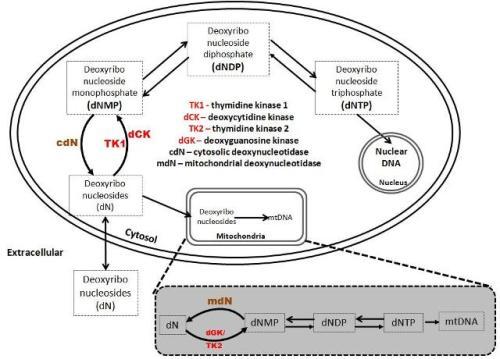AIM
The aim of this study is to investigate the Dm-dNK expression in mice. The enzymatic activities of the Dm-dNK and the wild-type thymidine kinase enzymes were analyzed and different features of the mice such as growth rate, organ weight, mortality and mtDNA were compared.
Background
Mitochondria are present in all eukaryotic cells and have the function of generating ATP for the survival of the cells. They contain their own DNA and have their own machinery for transcription and translation processes. The synthesis of mtDNA is not cell cycle regulated and requires a constant supply of deoxyribonucleoside triphosphates (dNTPs) for maintenance of the mitochondrial integrity. In non-replicating cells, the mtDNA synthesis depends on the salvage pathway enzymes – the deoxyribonucleoside kinases (dNKs).
The deoxyribonucleoside kinases (dNK) catalyze the phosphorylation of the deoxyribonucleosides (dN) into deoxyribonucleoside monophosphates (dNMPs), which are precursors of the dNTPs.
In mammals, there are four dNKs with overlapping specificities:
thymidine kinase 1 (TK1), deoxycytidine kinase (dCK) - Cytoplasmic enzymes
thymidine kinase 2 (TK2), deoxyguanosine kinase (dGK), - Mitochondrial enzymes

Mitochondrial DNA depletion syndrome (MDS) is a heterogeneous group of mitochondrial disorders characterized by reduced levels of mtDNA. Mutations in the nuclear encoded dNKs; dGK and TK2, have been associated with a hepatocerebral and myopathic forms of MDS, respectively.
Deoxyribonucleoside kinase from Drosophilla melanogaster (Dm-dNK) is a multisubstrate kinase (cytosolic) that has unique properties to recognize all four natural nucleosides. It has broad substrate specificity and high catalytic rates. It can be expressed at high levels with high enzyme activity in mammalian cells and can be used as a suicide gene in cancer cells.
Responsible for this page:
Director of undergraduate studies Biology
Last updated:
05/22/11
